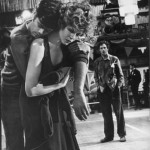Dancing With Change – Step Eight
The steps of learning to dance with change:
One: Accept that which cannot be changed.
Two: Choose—will you dance or sit this one out?
Three: Determine how much of this new dance you already know.
Four: Determine your role—Lead or Follower?
Five: Focus on learning the new dance.
Six: Start with the frame—it’s everything.
Seven: If you step on your partner’s toes, apologize and keep dancing.
Eight: Find partners who are better at the dance than you.
Master motivator Tony Robbins puts it this way, “If you want to be successful, find someone who has achieved the results you want and copy what they do and you’ll achieve the same results.” In other words, true to the principles of the Law of Attraction, you get more of what you focus on.
Too often we focus on looking good or on being better than others. In order to avoid feelings of vulnerability, we choose to interact only with those whose skills are inferior to ours. It’s easy to be the best in a sea of mediocrity.
As in any group, the dance community is comprised both of people who are committed to continual improvement and those who are content with “good enough.” There’s nothing wrong with the latter; it doesn’t, however, allow you to routinely exercise the “muscle” required to easily adapt to change.
“Good enough” is fine if you plan to dance with the same partner every time and you both agree to stay at that level. On the other hand, if you get into a situation where you are dancing with a different partner who is at a higher level, it could be hard for you to adapt to his/her style because you’ve been at “good enough” for so long. In a work situation, what this looks like is a team where some are pulling more of the weight than others and problems arise.
The best dancers, when they are trying to learn a new dance or get better at one they already know, look for someone who is extremely good at it and model what s/he does. Because they are dedicated to the goal of getting better, they willingly put themselves into a situation of vulnerability where they are not the best.
Surrounding yourself with those who have mastered what you are trying to achieve will ensure that you improve faster. As a bonus you will be exposed to new techniques and subtle nuances that are never seen in “good enough”.
Whenever you are faced with a change you can not or choose not to walk away from, learning what’s required to do this “new dance” is unavoidable. You can either learn everything the hard way (kicking and screaming) or be more like those dancers who are dedicated to getting better by volunteering to learn. The volunteers have learned the secret Tony Robbins talks about—they find someone to model.
A few years ago I was faced with a major change—arthritis in my left knee caused by surgery 30 years prior. It was so painful that when I turned over in my sleep at night I would cry out. Of course, being a bit of a “catastrophizer,” I envisioned all sorts of horrible outcomes and even began proactively mourning the things I was “sure” I’d never be able to do again (including dance).
Then I looked for potential solutions. I talked to my chiropractor. He told me what athletes do when they run into knee problems. At his urging, I began to do the same exercises to strengthen the muscles supporting my knee. Then I found Tami Lacey—an amazing trainer who modeled for me the exercises I could do to get really strong. (And then she stood over me to make sure I actually did them!)
Within two years I was able to hike to 8,000 feet in the Italian Alps and finish the 39-mile Avon Two-Day Walk for Breast Cancer. Imagine how different the results would have been if I had decided to model those who solved this same problem through pain medication or surgery. (Please—no emails! I understand that some situations are so bad that there are no other choices—luckily that wasn’t the case for me!)
I never needed to meet those “dance partners” who were better at the dance of recovery from knee problems than I was. As you move through this fast-changing world you have available to you many incredible models to help you dance with change. Find them. They are among your co-workers and friends, on the Internet, in your doctor’s office, in your schools and in your libraries.
We live in a remarkable time when Dancing With Change is not only possible, it can be quite easy—especially if you find and learn from partners who are better at the dance than you!

